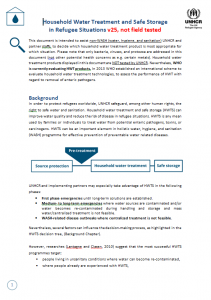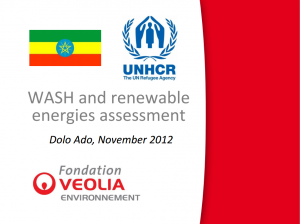This 289 page document provides and extensive introduction to applied hydrology and includes the following chapters: Introduction to the training course; Introduction to hydrogeology I; Introduction to hydrogeology II; Basic concepts of groundwater exploration; Bacteriological analysis of water; Basic concepts of groundwater protection; Basic concepts of aquifer characterisation: pumping tests; Well construction and rehabilitation
Recharge quantification in semi-arid areas with remote sensing;
Archives
Introduction to Hydrogeology (Université de Neuchâtel, SDC and UNHCR, 2015)

EPANET Training Course (SDC, 2015)

This 161 page document provides a thorough introduction to EPANET (US Environmental Protection Agency) water distribution network modelling software with a focus on designing networks for refugee settings.
- Tags: Piped Water Networks. Organisations: SDC and SDC. Categories: Training Materials and Training Materials.
Household Water Treatment and Safe Storage in Refugee Situations, (UNHCR, 2015)

This document contains guidelines to help WASH actors in refugee settings select household water treatment products. The document includes an overview of: • Categories of HWTS; • Health benefits; • When to use HWTS and existing decision tree; • Criteria regarding HWT to be considered by the field; • Mandatory components; • UNHCR Checklist for HWTS; • HWT concerns; • Household water treatment cards; • Safe water storage;• Further reading; • Acknowledgement
- Tags: WASH Strategy Development.
Hepatitis E Response in Refugee Settings (UNHCR, 2015)

This brief is intended to highlight key elements of an effective response to an outbreak of hepatitis E virus (HEV) infection in refugee setting. It focuses on specific response actions, including the review of common risks associated with health, water, sanitation, and hygiene (WASH). The overall implementation of response actions and mode of operation should be context specific, as highlighted by the examples given from Dadaab (Ifo) Kenya and South Sudan.
- Tags: Handwashing with Soap, Hygiene Promotion, and Public Health. Locations: South Sudan and Sudan and Chad Special Operational Region. Categories: WASH Emergency Guidelines, WASH Guidelines, WASH Guidelines, WASH Operational Guidelines, and WASH Policy Guidelines.
Water Quality Study in Refugee Operations (UNHCR and SMU, 2011)

The SMU team conducted five sampling missions to UNHCR refugee camps in Uganda, Kenya, Bangladesh, Djibouti, and Liberia. Overall, these missions were considered a success with 17 camps, 7 villages, and a few additional sites visited. The team collected 213 camp samples and 229 total samples for analyses in the laboratory. Camp conditions and source water characteristics varied widely amongst the five countries but also within the camps themselves.
- Locations: Bangladesh, Djibuti, Liberia, and Uganda. Organisations: Southern Methodist University.
Drinking Water, Sanitation and Renewable Energies Assessment – Dolo Ado Camp (Veolia Foundation and UNHCR, 2012)

This document looks at drinking water, sanitation and renewable energy solutions and options in three camps in Dolo Odo with recommendations and conclusions.
- Tags: Solar Pumping and Value for Money. Organisations: Veolia Foundation.
Implementing Urine Diversion Dry Toilets in Dolo Addo, Ethiopia (UNHCR, OXFAM GB and CDC, 2014)

The choice of sanitation technology in humanitarian crisis is based on various factors including the terrain, social and cultural norms and agency experience. There is the continued need for humanitarian response mechanisms to factor the environmental impact and sustainability of the technologies used in the provision of safe water supply and sanitation to affected communities. The acceptability of using ecological sanitation technologies such as Urine Diversion Dry Toilets (UDDT) in refugee contexts needs significant exploration. Using refugee camps in Dollo Ado as a case study, this paper outlines how the UDDT technology has been implemented in the context of protracted refugee camps, the successes and the areas needing further exploration to make it better able to be adopted across various refugee programmes and contexts.
- Tags: Excreta / Urine ReUse, Excreta / Urine ReUse, Excreta Composting, Excreta Composting, Excreta Management, Excreta Management, Excreta Management, and Excreta Treatment. Locations: Dollo Ado, Dollo Ado, Ethiopia, and Ethiopia. Organisations: OXFAM GB.
Decay of Chlorine: Building the Evidence Base for Humanitarian Safe Water Supply, (Berkeley University and UNHCR, 2014)

Current emergency safe water guidelines are based on little field evidence. We launched an observational study on chlorine decay in the Azraq refugee camp, Jordan in July-August 2014 in order to: i) develop evidence-based guidelines for centralized batch chlorination in humanitarian operations; and ii) identify factors affecting the safe water chain. This study builds on earlier work from South Sudan and adds to the evidence base that study initiated.
- Tags: Bulk Water Treatment, Bulk Water Treatment, Household Water Treatment, Household Water Treatment, and Household Water Treatment. Locations: Azraq, Jordan, and Middle East. Organisations: Berkeley University.
Sustainable Groundwater Management for Refugee Camps in Dadaab, Kenya (UNHCR and Université de Neuchâtel, 2013)

Close to half a million refugees live in Dadaab, Kenya and rely on groundwater from the Merti Aquifer. Preliminary hydrogeological mapping indicates over exploitation of the fresh water aquifer could result in salt water intrusion, which would put the security of water supply for the refugee camps and host population at risk. UNHCR together with University of Neuchâtel has embarked on a comprehensive study of the Merti Aquifer including remote monitoring, and numerical modelling of the aquifer in order to develop a sustainable groundwater management plan for the aquifer which supplies water to all the refugee camps in Dadaab, Kenya.
- Tags: Boreholes, Boreholes, Drilling, Drilling, and Groundwater. Organisations: UNHCR, UNHCR, UNHCR, UNHCR, UNHCR, UNHCR, UNHCR, UNHCR, Université de Neuchâtel, Université de Neuchâtel, WEDC, and WEDC. Categories: WASH Research Documents, WASH Research Documents, WASH Research Documents, WASH Research Documents, WASH Research Documents, and WASH Research Documents.
Water Safety Plan for Dadaab Refugee Camps (CDC, 2009)

Water safety plan produced by CDC following a technical support visit to Dadaab in 2009. The report contains: An overview of Dadaab water supply system; Identification of hazards and risks; Control measures and prioritisation of risks; Sanitation and hygiene; and Conclusions.
- Tags: Water Quality Testing and Surveillance, Water Quality Testing and Surveillance, Water Quality Testing and Surveillance, Water Quality Testing and Surveillance, Water Quality Testing and Surveillance, Water Safety Plans, Water Safety Plans, Water Safety Plans, Water Supply, Water Supply, Water Supply, Water Supply, Water Supply, Water Supply, and Water Supply. Locations: Africa, Africa, Africa, Africa, Africa, Dadaab, Dadaab, Dadaab, East and Horn of Africa, East and Horn of Africa, East and Horn of Africa, East and Horn of Africa, East and Horn of Africa, Kenya, Kenya, Kenya, and Kenya. Organisations: CDC and CDC. DatabaseDocTypes: Water Safety Plans. Categories: WASH Reference Documents, WASH Reference Documents, WASH Reference Documents, WASH Reference Documents, WASH Reference Documents, WASH Reference Documents, WASH Reference Documents, WASH Reference Documents, and WASH Reference Documents.
 English
English
